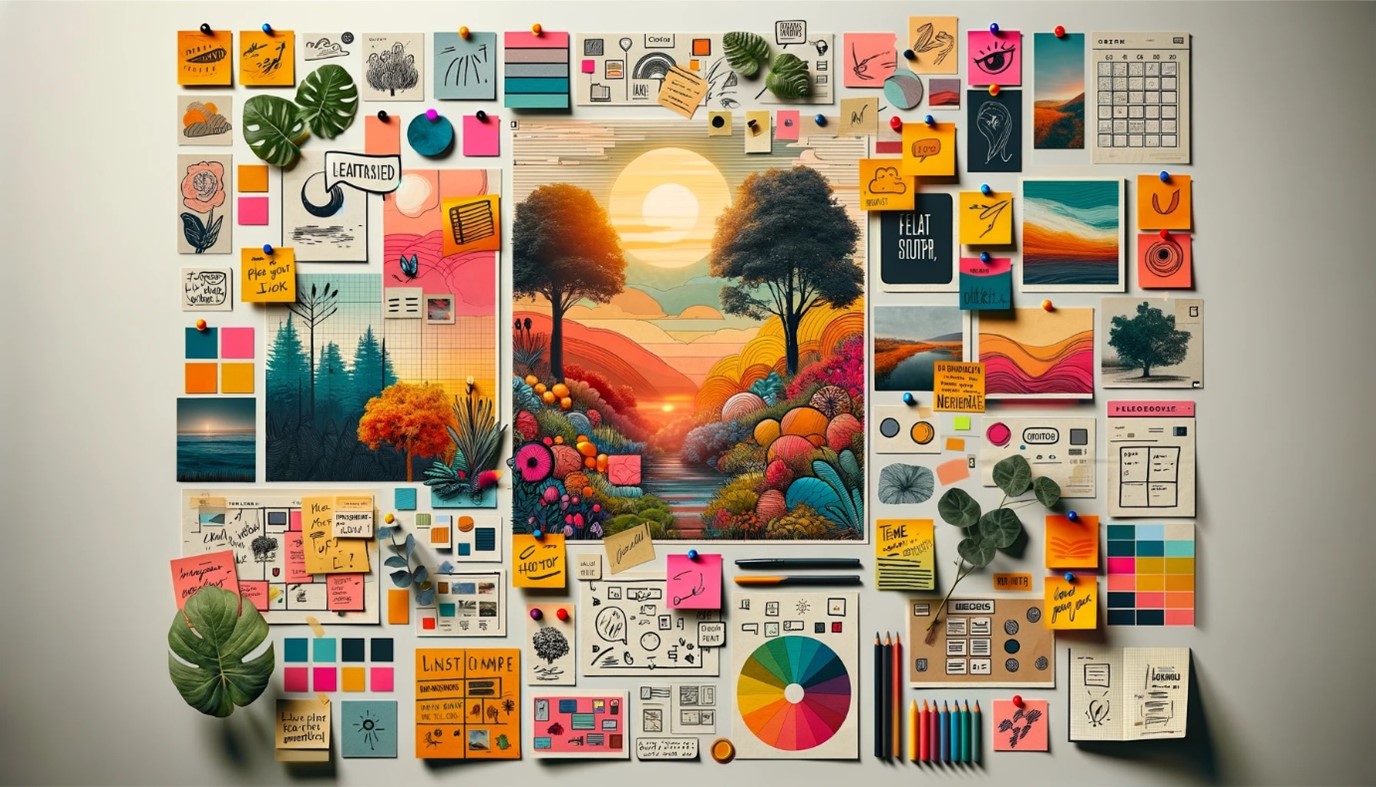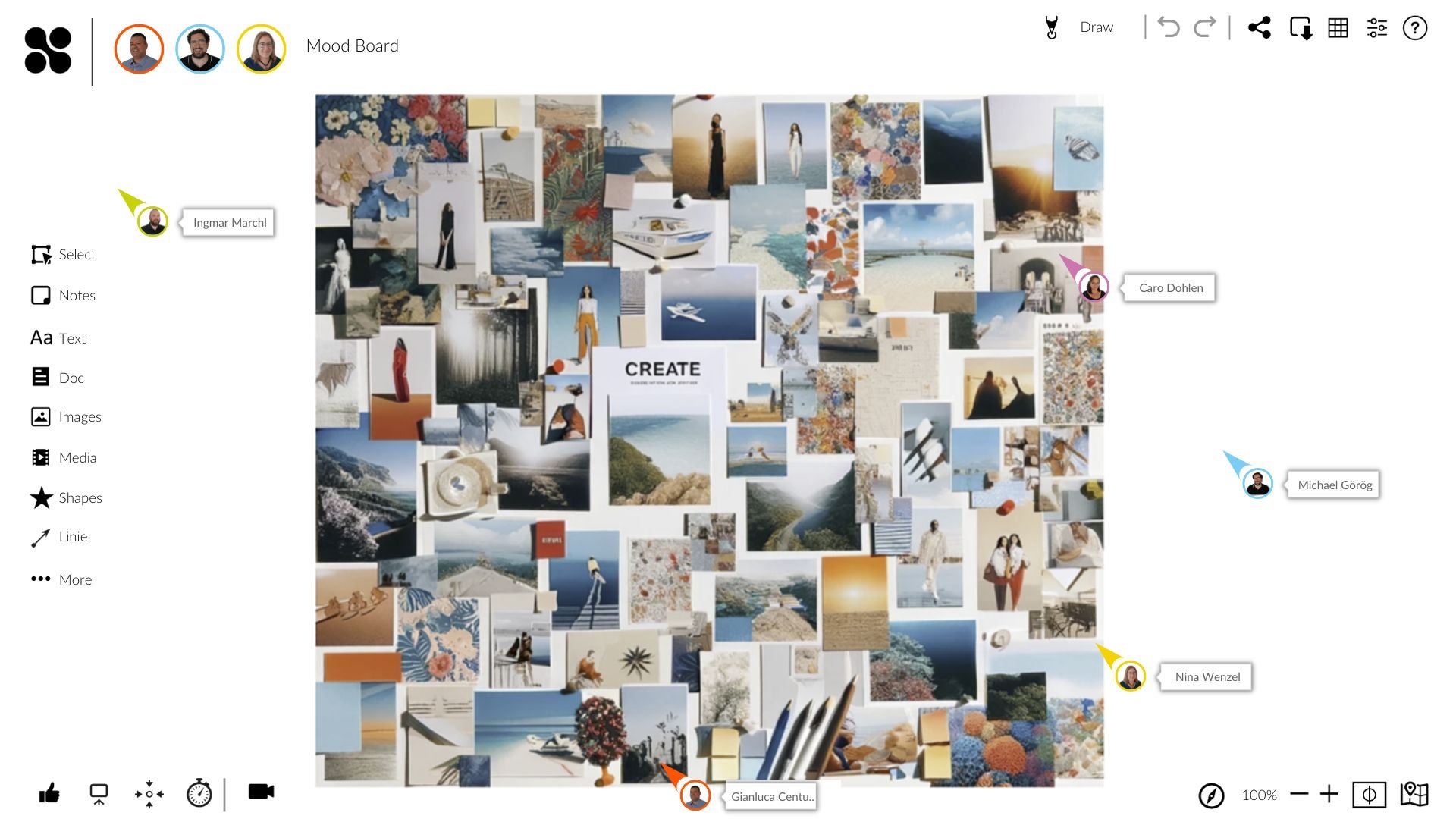In the dynamic fields of design and creativity, transforming an initial idea into a fully realized project is exciting and complex. At the heart of this creative journey lies the mood board, a tool that brings together visuals, text, and various elements to paint a picture of your vision. Mood boards are more than just collections of ideas; they are the bridges between imagination and reality, helping to guide the creative process and communicate abstract concepts in a clear, visual format.
Enter Collaboard, a modern digital platform designed to revolutionize how we create mood boards. With its intuitive interface and collaborative features, Collaboard offers a seamless experience for anyone looking to bring their ideas to life. Whether you're a professional designer, a marketing strategist, or even a hobbyist planning your next big project, Collaboard provides the tools you need to visually organize your thoughts and inspirations.
In this article, we'll delve into the power of mood boards as a creative tool and demonstrate how Collaboard can transform your conceptual ideas into concrete visual representations. From easy-to-use design features to real-time collaboration, we'll explore how Collaboard elevates the mood-boarding experience, making it an essential tool for anyone in the creative domain.
What is a Mood Board?
A mood board is essentially a visual collage that captures the essence of a project's concept. It's a creative mosaic where images, text, colors, and various materials coalesce to depict an idea or theme. This tool is especially useful in fields like graphic design, interior decorating, fashion, and branding, where visual aesthetics play a crucial role.
The real power of a mood board lies in its ability to translate abstract ideas into tangible visuals. It allows creators to experiment with different themes, styles, and moods before committing to a final design. This saves time and resources and ensures that the end product aligns with the envisioned concept.
In the traditional sense, mood boards are often physical boards or scrapbooks. However, the digital era has brought about a significant shift, making mood boards more dynamic and accessible. Digital mood boards offer the flexibility to easily incorporate and manipulate a wide range of media, from photographs and illustrations to video clips and sound bites.

The Evolution of Mood Boards: From Physical to Digital
Transitioning from physical to digital mood boards has been a game-changer. The digital format breaks the limitations of physical space and material constraints. With a few clicks, you can add, remove, or rearrange elements on your mood board without the need for physical resources. This adaptability makes digital mood boards a more sustainable and versatile choice for modern creators.
Moreover, digital mood boards like those created on Collaboard enable real-time collaboration. Team members, clients, or collaborators can contribute, comment, and share feedback instantly, no matter where they are. This collaborative aspect speeds up the decision-making process and fosters a more inclusive and interactive creative environment.
The Usefulness of Mood Boards
Mood boards are not just artistic tools; they serve a practical purpose in various professional scenarios. Whether it's in the brainstorming phase of a marketing campaign, the initial design process of a new fashion line, or the conceptual stage of an interior design project, mood boards play a pivotal role.
- Clarifying Vision and Concepts: Mood boards help in translating vague or complex ideas into clear, visual formats. This is particularly useful in initial client meetings or team brainstorming sessions where verbal descriptions might fall short.
- Inspiring Creativity: They act as a source of inspiration, sparking new ideas and directions. By visually arranging different elements, mood boards can reveal unexpected connections and creative paths.
- Facilitating Communication: Mood boards are excellent communication tools, especially when working with diverse teams or clients. They ensure everyone is on the same page, reducing misunderstandings and aligning visions.
- Guiding Decision Making: They provide a reference point for making design decisions, helping to maintain consistency in style, tone, and aesthetic throughout a project.
Who Should Use Mood Boards?
Mood boards are versatile tools that can be beneficial for a wide range of professionals and hobbyists:
- Designers (Graphic, Fashion, Interior, etc.): For visualizing concepts and experimenting with different styles.
- Marketing Professionals: To conceptualize branding and campaign ideas.
- Event Planners: For envisioning event themes and decorations.
- Educators and Students: As a teaching tool or for project presentations.
Creating a Mood Board with Collaboard
Now, let's explore how Collaboard transforms the process of creating a mood board. Collaboard, with its user-friendly interface and versatile features, makes it easy and efficient to create digital mood boards. Here's how you can leverage Collaboard for your mood boarding needs:
- Starting Your Project: Choose from a variety of templates or start with a blank slate.
- Adding Elements: Upload images, text, videos, and links. You can also use the drawing tools for custom creations.
- Customizing Your Board: Arrange and resize elements, change colors, and add annotations.
- Collaborating in Real-Time: Invite team members or clients to view and edit the mood board together, regardless of their location.
- Sharing and Exporting: Easily share your mood board with others or export it for presentations or further development.

Advantages of Digital Mood Boards (with Collaboard)
Digital mood boards, particularly those created with Collaboard, offer several advantages over traditional, physical mood boards:
- Flexibility and Ease of Revision: Digital mood boards allow for effortless modifications. With Collaboard, you can quickly add, remove, or rearrange elements without the need for physical materials or the risk of damaging your work.
- Unlimited Resources and Accessibility: Unlike physical boards, digital mood boards aren't limited by physical space or materials. Collaboard gives you access to a vast array of digital resources, including images, videos, and links, all within a single platform.
- Enhanced Collaboration: Collaboard takes collaboration to the next level. Team members can contribute to the mood board in real-time from different locations, making the creative process more dynamic and inclusive.
- Eco-Friendly and Cost-Effective: Digital mood boards eliminate the need for physical materials, reducing waste and expenses associated with printing and purchasing resources.
- Easy Sharing and Presentation: With Collaboard, you can easily share your mood board with clients or stakeholders and even present it directly from the platform, enhancing communication and efficiency.

Collaboard Features That Enhance Mood Board Creation
Collaboard isn't just about replacing paper and glue with pixels; it's about enhancing the entire mood-boarding process:
- Intuitive Design Interface: Collaboard’s interface is designed for ease of use, making it accessible to both professionals and amateurs.
- Real-Time Collaboration and Feedback: Collaborators can work together synchronously, providing instant feedback and suggestions, which is especially useful in team projects or client interactions.
- Diverse Media Integration: Whether it's images, videos, website links, or custom drawings, Collaboard supports a wide range of media formats, allowing for rich, multi-dimensional mood boards.
- Secure and Organized: Your ideas and projects are safe with advanced security features. The platform also helps keep your work organized, which is crucial for managing multiple projects.
- Accessibility Across Devices: Collaboard is accessible on various devices, ensuring you can work on your mood board anytime, anywhere, fostering a flexible working environment.
Conclusion - Why create Mood Boards with an Online Whiteboard software
Mood boards are vital in the creative process, serving as a visual language that translates ideas into actionable designs. With the advent of digital tools like Collaboard, this process has become more accessible, collaborative, and efficient. Whether you are a seasoned designer, a marketing professional, or someone embarking on a personal project, Collaboard offers a dynamic and innovative platform to bring your visions to life.
Ready to transform your ideas into visually compelling stories? Explore the endless possibilities with Collaboard.
Mood Board - Frequent Questions and Answers
What is a mood board?
A mood board is a visual tool that displays a collection of images, materials, colors, and text related to a particular theme or style, used to convey a general idea or feeling about a project.
Why are mood boards used?
Mood boards are used to visually communicate the style, theme, or feel of a project, making it easier for designers, clients, and team members to align their visions and inspirations.
How do you create a mood board?
To create a mood board, gather images, color swatches, textures, and relevant materials that represent your ideas and arrange them creatively on a physical or digital platform.
What should be included in a mood board?
A mood board should include elements such as images, color palettes, textures, patterns, and typography that collectively convey the mood and style of your concept.
Can mood boards be digital?
Yes, mood boards can be digital, created using software or apps, allowing for easy sharing and editing.
How do mood boards help in the design process?
Mood boards help streamline the design process by providing a clear visual direction and inspiration, ensuring consistency in style and concept.
Who uses mood boards?
Mood boards are used by designers, artists, filmmakers, interior decorators, and other creative professionals to communicate and develop their ideas visually.
Is there a difference between a mood board and a concept board?
Yes, a mood board focuses more on the mood and feel, while a concept board is more specific, often including potential products, layouts, or detailed designs.
How many items should a mood board have?
The number of items on a mood board varies, but it should be balanced – enough to convey the mood clearly, but not so many that it becomes cluttered.
Can mood boards be used for non-design projects?
Absolutely, mood boards are versatile and can be used in various fields like marketing, event planning, fashion styling, and personal projects to visualize ideas or themes.





